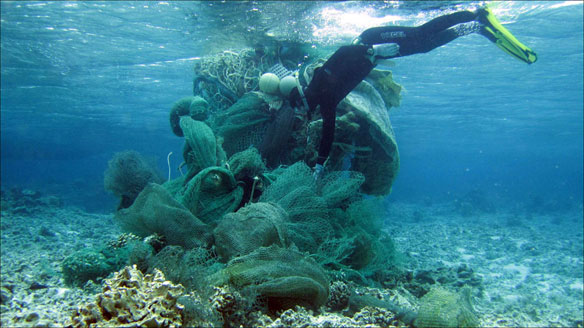
Russell Reardon dives in the waters of Midway Atoll on March 31, 2013, to remove a fishing net from a coral reef. “Marine debris, particularly discarded and lost fishing gear, is a substantial source of coral damage in the Northwestern Hawaiian Islands,” says team member Matthew Parry, a NOAA fisheries biologist. Captions and Photo source: NOAA
Credit: NOAA photo by James Morioka
Excerpts;
In an area of Hawaii, far removed from most human habitation, a recent cleanup effort yielded an 18-wheeler’s worth of human debris, consisted largely of derelict fishing gear and all sorts of plastic, during a 19-day anti-pollution campaign this year.
The largest single piece of debris removed by the team was a seven-meter-long vessel swept away during the March 2011 Tōhoku earthquake and tsunami in Japan.
The region, which includes Midway Atoll, some 1,200 miles (1,900 kilometers) from the Hawaiian mainland, acts as a “fine-tooth comb” in picking up debris from elsewhere,
The Coral Reef Ecosystem Division Marine Debris Project, run by NOAA’s Pacific Islands Fisheries Science Center, has collected 848 tons (769 metric tons) of debris —about the weight of 530 sedan-size cars—in the northwestern Hawaiian Islands since the program began in 1996.
Once the debris is picked up, NOAA works to recycle as much of it as possible. Nets, for example, are sent to Schnitzer Steel Hawaii Corp. on the mainland, where they are chopped up for the City and County of Honolulu’s H-Power plant to convert into electricity…

A NOAA team recently collected 14 metric tons of fishing gear, plastic, and other debris from the shoreline and waters around Midway Atoll. The collected debris consisted largely of derelict fishing gear and plastic. Captions and Photo source: NOAA
Read Full Article, LiveScience
NOAA Removes ’18-Wheeler’s Worth’ of Debris from Mid-Pacific Waters, NOAA
Message from the Gyre,from the Midway Series; courtesy of © Chris Jordan for Coastal Care








